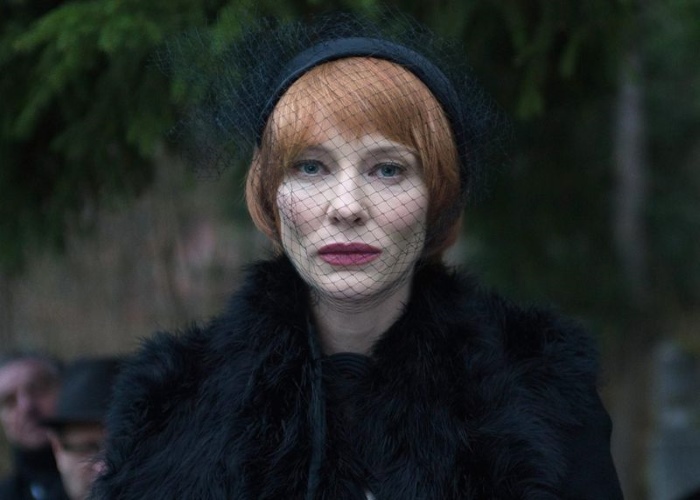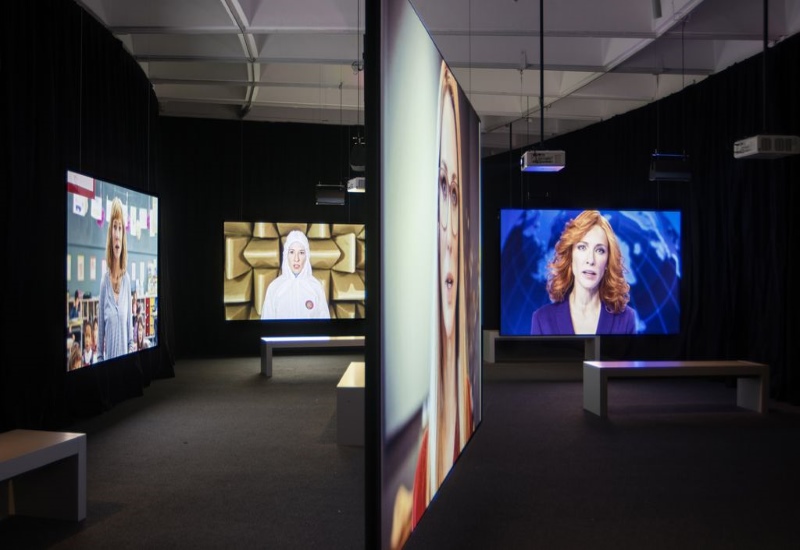Julian Rosefeldt’s “Manifesto,” on view at the Hirshhorn, puts a satiric spin on art history’s seminal texts

When contemplating an artwork suspended on a spotless museum wall, it’s only natural to speculate as to the circumstances that brought it there. What sort of life did the artist lead? What moments in history did they inhabit and respond to? What were their opinions of the world around them? Sometimes, artists go to their graves without offering any explanations at all, content to let their audience agonize. In other cases, the exact opposite is true, and creators lay out their beliefs in emphatic, no-holds-barred manifestoes, as if to head off any possible misreading of their work. But are manifestoes really to be trusted?
This question, coupled with a deep appreciation for the poetry of the manifesto form, was what led German artist Julian Rosefeldt to both celebrate and subvert some of art history’s most famous texts in a crazy—and crazy-ambitious—13-part video installation, now on view at the Smithsonian’s Hirshhorn Museum and Sculpture Garden in Washington, D.C., thanks to a partnership with the Goethe-Institut. Titled Manifesto, the work sees renowned stage and screen actress Cate Blanchett (Carol, Blue Jasmine) assume 13 separate personas across as many distinct vignettes.
In guises ranging from draconian schoolmarm to misanthropic homeless man (complete with scratchy voice and scraggly beard), Blanchett performs self-serious monologues assembled from excerpts of artistic manifestoes. Some of these documents are famous among art lovers, others more obscure, but all share the distinction of embodying major inflection points in the evolution of art worldwide. Each one of Blanchett’s roles, which she and Rosefeldt say are more like “vessels for ideas” than characters per se, corresponds to a specific artistic theme: futurism, say, or Dada, or surrealism. Both Rosefeldt and Blanchett are known for their academic chops, so the intellectual rigor of the piece comes as no surprise. What does, however, is how outrageously funny the installation is in places.

The comedy of “Manifesto” stems from Rosefeldt’s cheeky recontextualization of his source material. “Action happens that doesn’t belong,” he says. “Text happens that doesn’t belong.” One of the most striking examples of this is a melodramatic funeral scene in which Blanchett rises to give what viewers expect will be a hackneyed eulogy only to explode into a Dadaist tirade on the farce of bourgeois institutions and the pressing need to purge global society of all authoritarian structure. Adding to the absurdity of the moment is the fact that the grieving crowd sits stock-still and accepts the verbal punishment, raising no objection as the monologuing Blanchett heralds the death of their very way of life.
This sort of satire is as much about poking fun at the artists as it is about confronting their audience. Blanchett’s schoolteacher scene sees her didactically walking a class of young children through Jim Jarmusch’s “Golden Rules of Filmmaking” and related instructive texts. “You can steal from everywhere,” she intones, moving from desk to desk and criticizing each child’s work. “Architecture, cloud formations. . .” The stifling prescriptivism of the instructor is a perfect send-up of Jarmusch’s own tone throughout his “Rules,” and the contrived nature of the scene mirrors the contrived sets of “rules” that so many manifestoes arrive at with absolute certainty.
And yet, “Manifesto” is not mean-spirited. At the end of the day, Rosefeldt reveres much of his material, which he frequently finds eloquent and powerful. His aim is not to dismiss the manifestoes, but rather to enliven them with humor and playfully poke holes in their projected certitude. Many of us, he says, fall into the trap of consecrating the manifestoes of now-famous artists when in reality the artists wrote those texts in periods of deep personal uncertainty.
“We read them as very self-secure statements,” he says, “but for me they are the opposite. I think about that young punk in their 20s or 30s, sitting in a café and just writing down angry ideas because she or he is so insecure.”
The “Manifesto” video installation is the centerpiece of a larger Hirshhorn exhibition “Manifesto: Art X Agency,” which bookends Rosefeldt’s room of round-the-clock projection and audio with loosely chronological artworks from the museum’s collection representing 20th-century artistic movements linked intimately to manifesto texts.
As visitors move through the space, they first learn about the technologically obsessed Italian Futurism movement of the century’s early years, then dive into the anti-authoritarian Dada impulses that surged to the fore during World War I. They see Surrealism establish its toehold in the interwar period, drawing on Freudian psychology and the notion of subjective truth in response to mounting disillusionment.
Then come the introspective, often somber post-World War II studies in Abstract Expressionism, and later a pivot toward the overtly political with Pop Art, the rise of activist art collectives like the Guerrilla Girls, and ideological reinterpretations like Adam Pendleton’s Black Dada. Chief curator Stéphane Aquin notes that many of the more recent pieces in the show effectively “act as manifestoes [in their own right], in that they display a sense of agency.”
From end to end, the “Manifesto” exhibition spins a narrative of evolving ideologies, giving gallerygoers the historical context necessary to appreciate Rosefeldt’s playful distortion of that context in his 12-part audiovisual experience.
More than anything, Rosefeldt hopes his cinematic reimagining of artists’ manifestoes will lead visitors to the museum to question their assumptions about the tidiness of art history and put them in touch with the humanity, and fallibility, of his subjects. “The audience often takes for granted that whatever is presented in the white cube or on a pedestal is authoritative and completed,” he says. “And I don’t think that’s the case.”